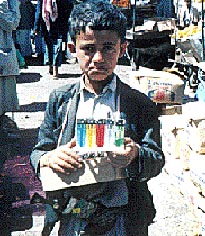
WORKING CHILDREN IN YEMEN: A GENERATION PRONE TO DISASTER [Archives:1999/47/Reportage]
November 22 1999
2nd in a Series
Mohammed Al-Qadhi,
Managing Editor
Major Force of Working Children
The phenomenon of the working child class in Yemeni society appeared visibly in 1990s. As a matter of fact, there are some major factors lying behind the proliferation of this phenomenon so widely and which have forced children to join the working class of Yemeni society.

The distribution of working children by economic activity shows that the large majority are involved in the agricultural sector (92%) and are from rural areas (96%).
As previously stated, the economic factor is the most important pressure forcing children to indulge in various types of work. As already mentioned, almost all of the rural working children (85%) work for their families without wages. They perform some agricultural work which has an economic value for their families.
We find that Yemen is one of the countries wherein the population growth rate (3.7%) and fertility rate (7.2%) is growing very fast. Reports say that if such growth continues, Yemen’s present population of 17.8 million will dramatically grow to 19.6 million by 2002 and is projected to jump to 27 million in 2010 and to a crashing 40 million by the year 2020. In, 1975 Yemen’s population was 8.1 million and in 1994 it reached 15.5 million. What is worse is that a high proportion of the population consists of young people. Around 2.5 million Yemenis are under four years-old, and another 5 million are between the ages of 5 and 14 years. Thus, infants and children represent 42.4% of the total population. This proportion will rise to 50% by the year 2010. So, these figures offer a scary and menacing picture. This population explosion adds fuel to the fire. This means that a lot of development services will be demanded which the shaky Yemeni economy, mainly because of corruption, is not able to afford.
Therefore, a lot of families in such difficult economic situations, in which the per capita income is roughly $276, can not afford to educate and feed their kids. Therefore, they are sent forcibly to perform any activity of economic value so as to help their families in their living. I conducted a questionnaire to find out the reasons forcing children to work. The questionnaire focused on the major cities in Yemen. Around 76% out of the respondents stated that they perform work activities in order to help their families sustain living, mainly because their fathers work can not cover the family needs.
We also find that the return of around one million Yemeni expatriates from the Gulf countries due to the Gulf War of 1990 has exacerbated the situation and added oil to the fire. Most of these returnees are not well-qualified. They formed a heavy burden on the fragile economy of Yemen and pushed the unemployment rate (around 40% now) forward. As a result, these returnees were unable to afford the basic needs for their families.
Therefore, they forced their kids to either work or beg to help them. Hence, the number of people living below the line of poverty (30%) is on the rise. These economic factors together have forced kids to search for work.
To be continued next week
——
[archive-e:47-v:1999-y:1999-d:1999-11-22-p:./1999/iss47/report.htm]


